System Requirements: Analysis, Design, and Implementation Report
VerifiedAdded on 2022/09/12
|18
|2262
|19
Report
AI Summary
This report provides a comprehensive analysis of system requirements, focusing on the importance of understanding user needs and business contexts in system design. It begins with an introduction to the concept of system requirements and their potential pitfalls, especially when the focus is solely on the system rather than the user. The report presents a pictorial model of an organization, including a high-level organizational chart, stakeholder chart, and vision and mission statements. It then delves into a consolidated domain model and class diagrams, alongside two user stories complete with acceptance criteria, emphasizing the role of clear communication and documentation in software development. The report uses case diagrams and descriptions to connect the problem of requirements not being attached to user association. The report highlights the value of use cases in detailing user-system interactions, and concludes by summarizing the main components of use cases and providing references to relevant literature.

Running head: REPORT ON SYSTEM REQUIREMENTS
By
Academic Year: 2019-20
Module: System Requirements
By
Academic Year: 2019-20
Module: System Requirements
Paraphrase This Document
Need a fresh take? Get an instant paraphrase of this document with our AI Paraphraser
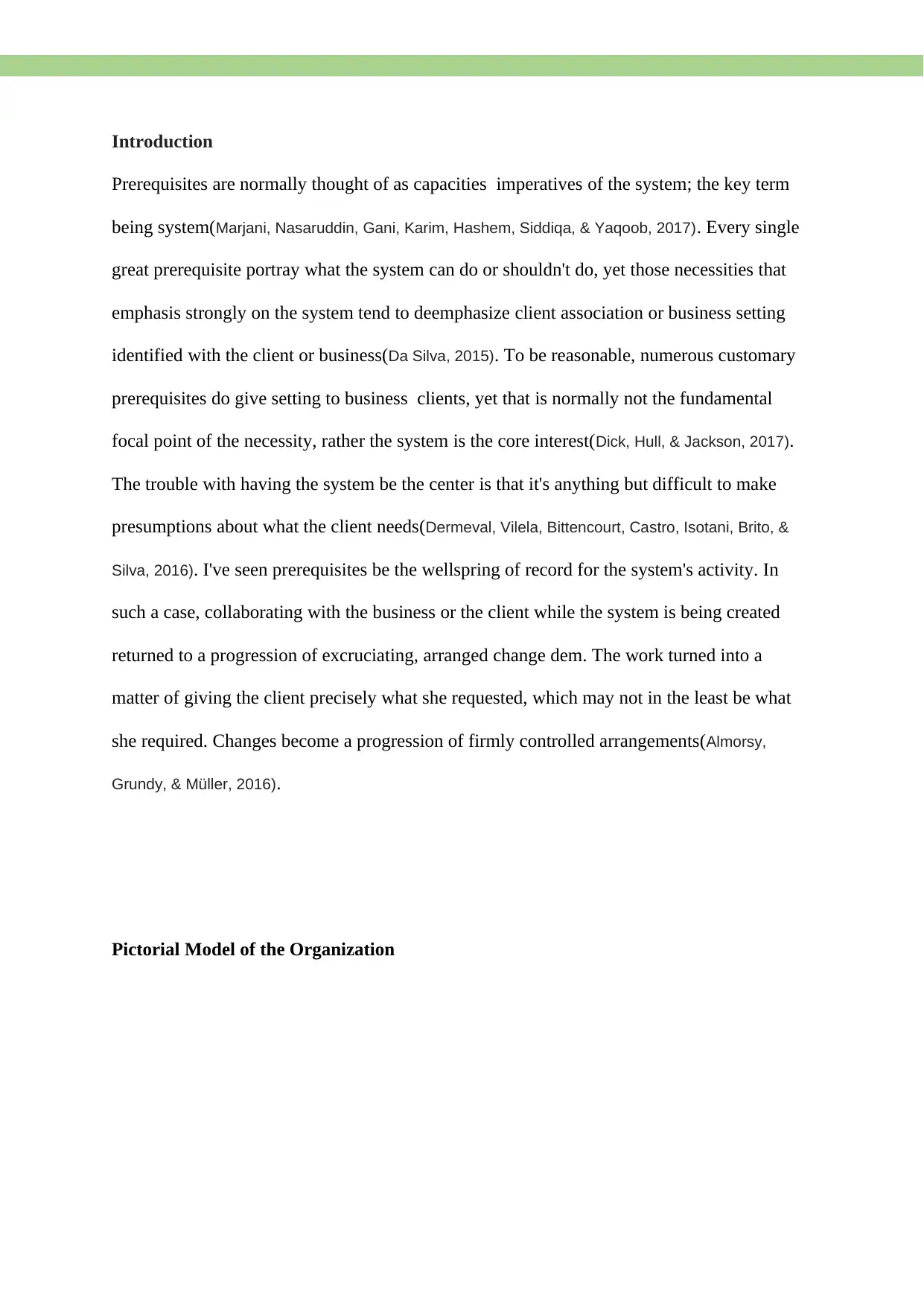
Introduction
Prerequisites are normally thought of as capacities imperatives of the system; the key term
being system(Marjani, Nasaruddin, Gani, Karim, Hashem, Siddiqa, & Yaqoob, 2017). Every single
great prerequisite portray what the system can do or shouldn't do, yet those necessities that
emphasis strongly on the system tend to deemphasize client association or business setting
identified with the client or business(Da Silva, 2015). To be reasonable, numerous customary
prerequisites do give setting to business clients, yet that is normally not the fundamental
focal point of the necessity, rather the system is the core interest(Dick, Hull, & Jackson, 2017).
The trouble with having the system be the center is that it's anything but difficult to make
presumptions about what the client needs(Dermeval, Vilela, Bittencourt, Castro, Isotani, Brito, &
Silva, 2016). I've seen prerequisites be the wellspring of record for the system's activity. In
such a case, collaborating with the business or the client while the system is being created
returned to a progression of excruciating, arranged change dem. The work turned into a
matter of giving the client precisely what she requested, which may not in the least be what
she required. Changes become a progression of firmly controlled arrangements(Almorsy,
Grundy, & Müller, 2016).
Pictorial Model of the Organization
Prerequisites are normally thought of as capacities imperatives of the system; the key term
being system(Marjani, Nasaruddin, Gani, Karim, Hashem, Siddiqa, & Yaqoob, 2017). Every single
great prerequisite portray what the system can do or shouldn't do, yet those necessities that
emphasis strongly on the system tend to deemphasize client association or business setting
identified with the client or business(Da Silva, 2015). To be reasonable, numerous customary
prerequisites do give setting to business clients, yet that is normally not the fundamental
focal point of the necessity, rather the system is the core interest(Dick, Hull, & Jackson, 2017).
The trouble with having the system be the center is that it's anything but difficult to make
presumptions about what the client needs(Dermeval, Vilela, Bittencourt, Castro, Isotani, Brito, &
Silva, 2016). I've seen prerequisites be the wellspring of record for the system's activity. In
such a case, collaborating with the business or the client while the system is being created
returned to a progression of excruciating, arranged change dem. The work turned into a
matter of giving the client precisely what she requested, which may not in the least be what
she required. Changes become a progression of firmly controlled arrangements(Almorsy,
Grundy, & Müller, 2016).
Pictorial Model of the Organization
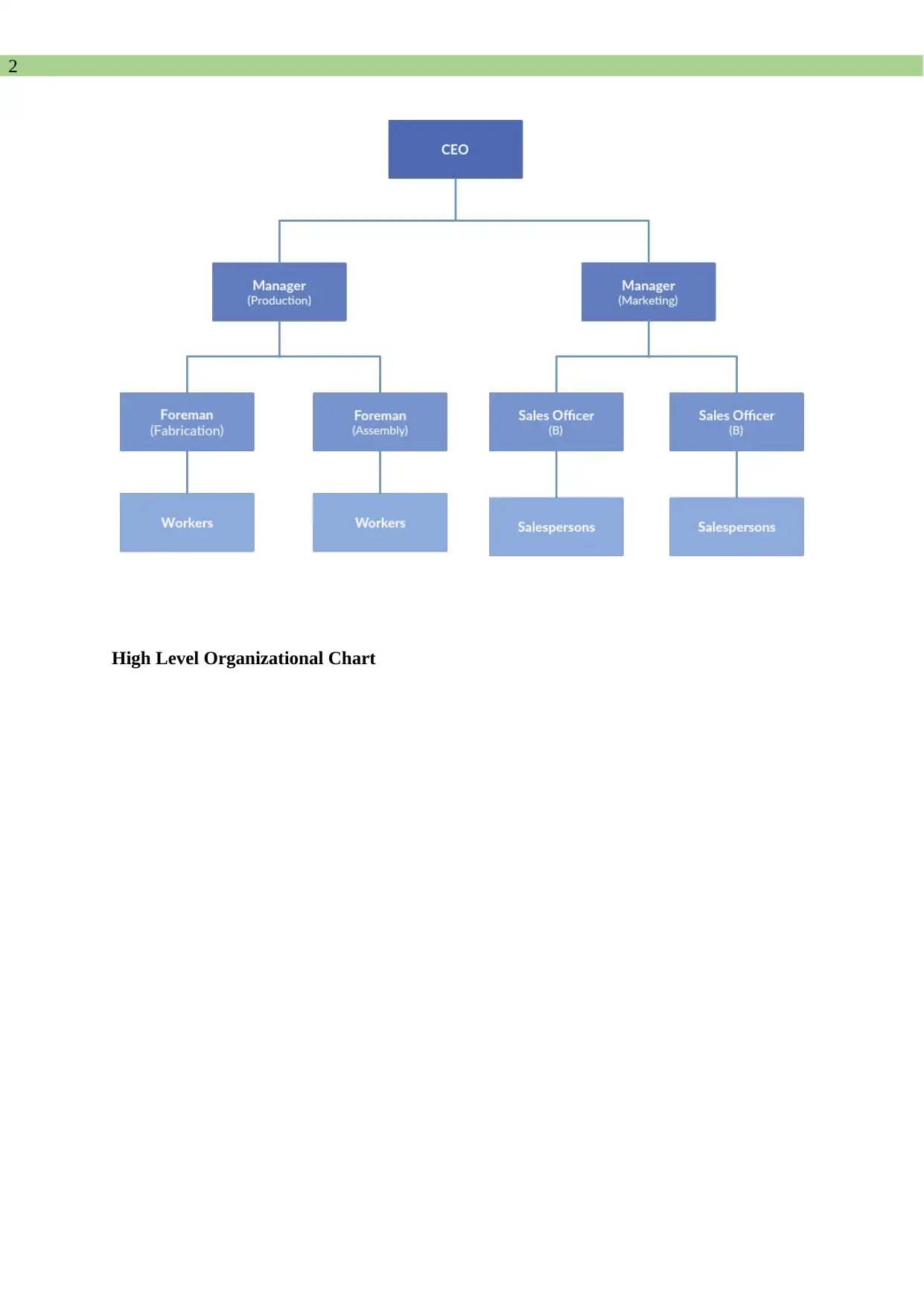
2
High Level Organizational Chart
High Level Organizational Chart
⊘ This is a preview!⊘
Do you want full access?
Subscribe today to unlock all pages.

Trusted by 1+ million students worldwide

3
Stakeholder Chart
Stakeholder Chart
Paraphrase This Document
Need a fresh take? Get an instant paraphrase of this document with our AI Paraphraser
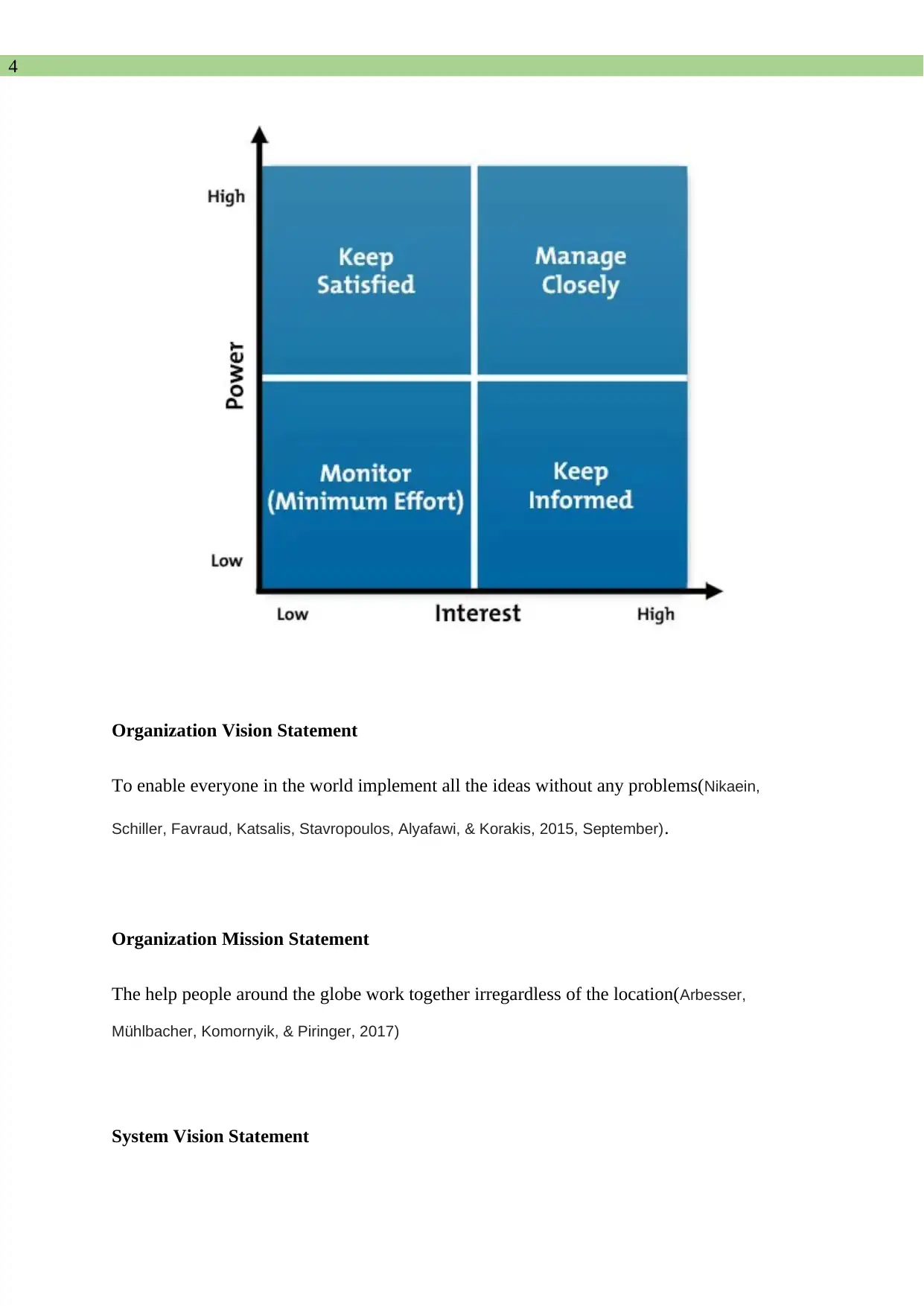
4
Organization Vision Statement
To enable everyone in the world implement all the ideas without any problems(Nikaein,
Schiller, Favraud, Katsalis, Stavropoulos, Alyafawi, & Korakis, 2015, September).
Organization Mission Statement
The help people around the globe work together irregardless of the location(Arbesser,
Mühlbacher, Komornyik, & Piringer, 2017)
System Vision Statement
Organization Vision Statement
To enable everyone in the world implement all the ideas without any problems(Nikaein,
Schiller, Favraud, Katsalis, Stavropoulos, Alyafawi, & Korakis, 2015, September).
Organization Mission Statement
The help people around the globe work together irregardless of the location(Arbesser,
Mühlbacher, Komornyik, & Piringer, 2017)
System Vision Statement

5
To enable everyone is achieve the best on different areas.
Consolidated Domain Model Class Diagram
Two User Stories complete with statement acceptance criteria
Accomplishment of any undertaking relies upon the capacity of an improvement group to
address their customer's issues. The correspondence between the customer and the
advancement group assumes a fundamental job in conveying an answer that fits item and
To enable everyone is achieve the best on different areas.
Consolidated Domain Model Class Diagram
Two User Stories complete with statement acceptance criteria
Accomplishment of any undertaking relies upon the capacity of an improvement group to
address their customer's issues. The correspondence between the customer and the
advancement group assumes a fundamental job in conveying an answer that fits item and
⊘ This is a preview!⊘
Do you want full access?
Subscribe today to unlock all pages.

Trusted by 1+ million students worldwide
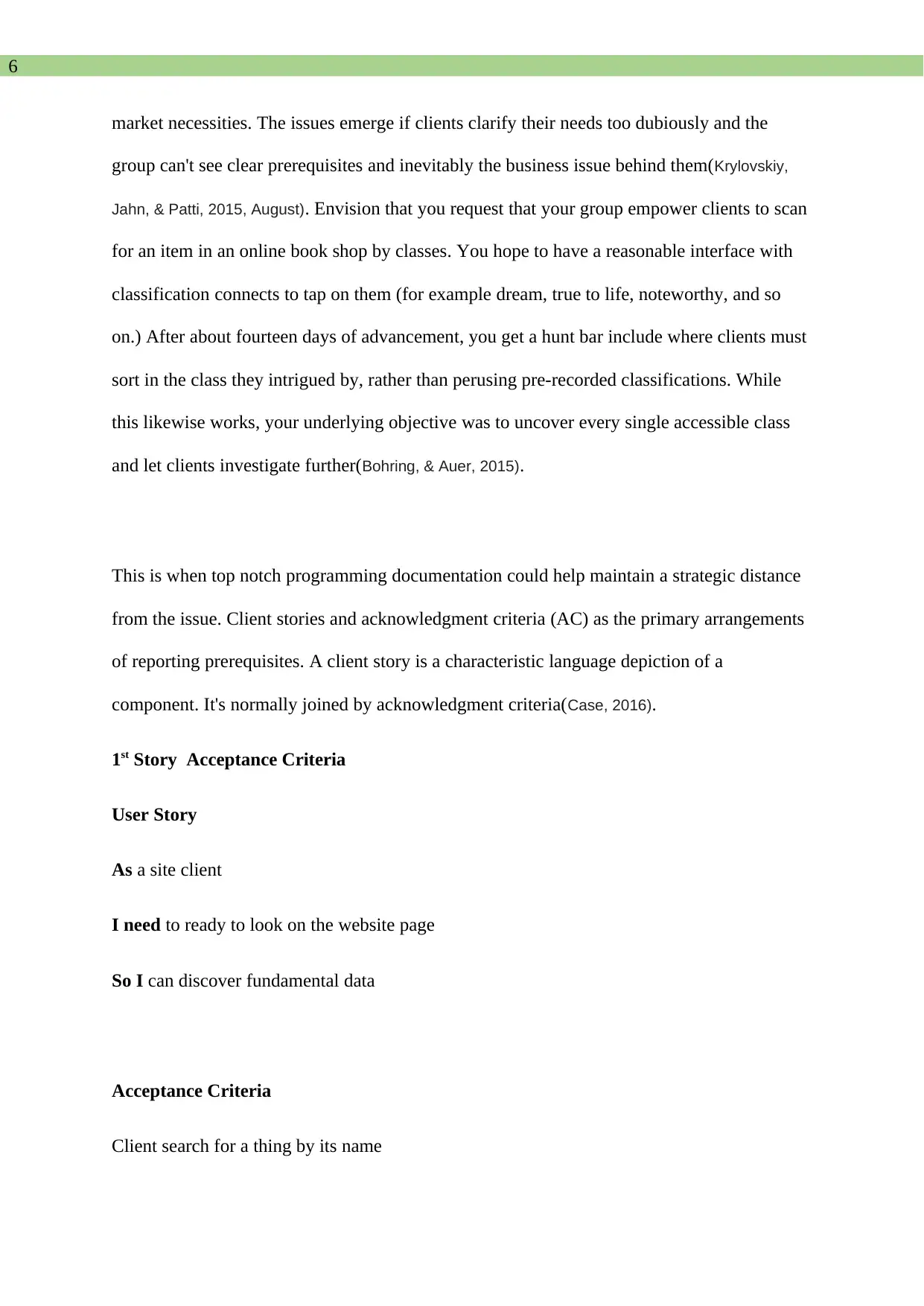
6
market necessities. The issues emerge if clients clarify their needs too dubiously and the
group can't see clear prerequisites and inevitably the business issue behind them(Krylovskiy,
Jahn, & Patti, 2015, August). Envision that you request that your group empower clients to scan
for an item in an online book shop by classes. You hope to have a reasonable interface with
classification connects to tap on them (for example dream, true to life, noteworthy, and so
on.) After about fourteen days of advancement, you get a hunt bar include where clients must
sort in the class they intrigued by, rather than perusing pre-recorded classifications. While
this likewise works, your underlying objective was to uncover every single accessible class
and let clients investigate further(Bohring, & Auer, 2015).
This is when top notch programming documentation could help maintain a strategic distance
from the issue. Client stories and acknowledgment criteria (AC) as the primary arrangements
of reporting prerequisites. A client story is a characteristic language depiction of a
component. It's normally joined by acknowledgment criteria(Case, 2016).
1st Story Acceptance Criteria
User Story
As a site client
I need to ready to look on the website page
So I can discover fundamental data
Acceptance Criteria
Client search for a thing by its name
market necessities. The issues emerge if clients clarify their needs too dubiously and the
group can't see clear prerequisites and inevitably the business issue behind them(Krylovskiy,
Jahn, & Patti, 2015, August). Envision that you request that your group empower clients to scan
for an item in an online book shop by classes. You hope to have a reasonable interface with
classification connects to tap on them (for example dream, true to life, noteworthy, and so
on.) After about fourteen days of advancement, you get a hunt bar include where clients must
sort in the class they intrigued by, rather than perusing pre-recorded classifications. While
this likewise works, your underlying objective was to uncover every single accessible class
and let clients investigate further(Bohring, & Auer, 2015).
This is when top notch programming documentation could help maintain a strategic distance
from the issue. Client stories and acknowledgment criteria (AC) as the primary arrangements
of reporting prerequisites. A client story is a characteristic language depiction of a
component. It's normally joined by acknowledgment criteria(Case, 2016).
1st Story Acceptance Criteria
User Story
As a site client
I need to ready to look on the website page
So I can discover fundamental data
Acceptance Criteria
Client search for a thing by its name
Paraphrase This Document
Need a fresh take? Get an instant paraphrase of this document with our AI Paraphraser
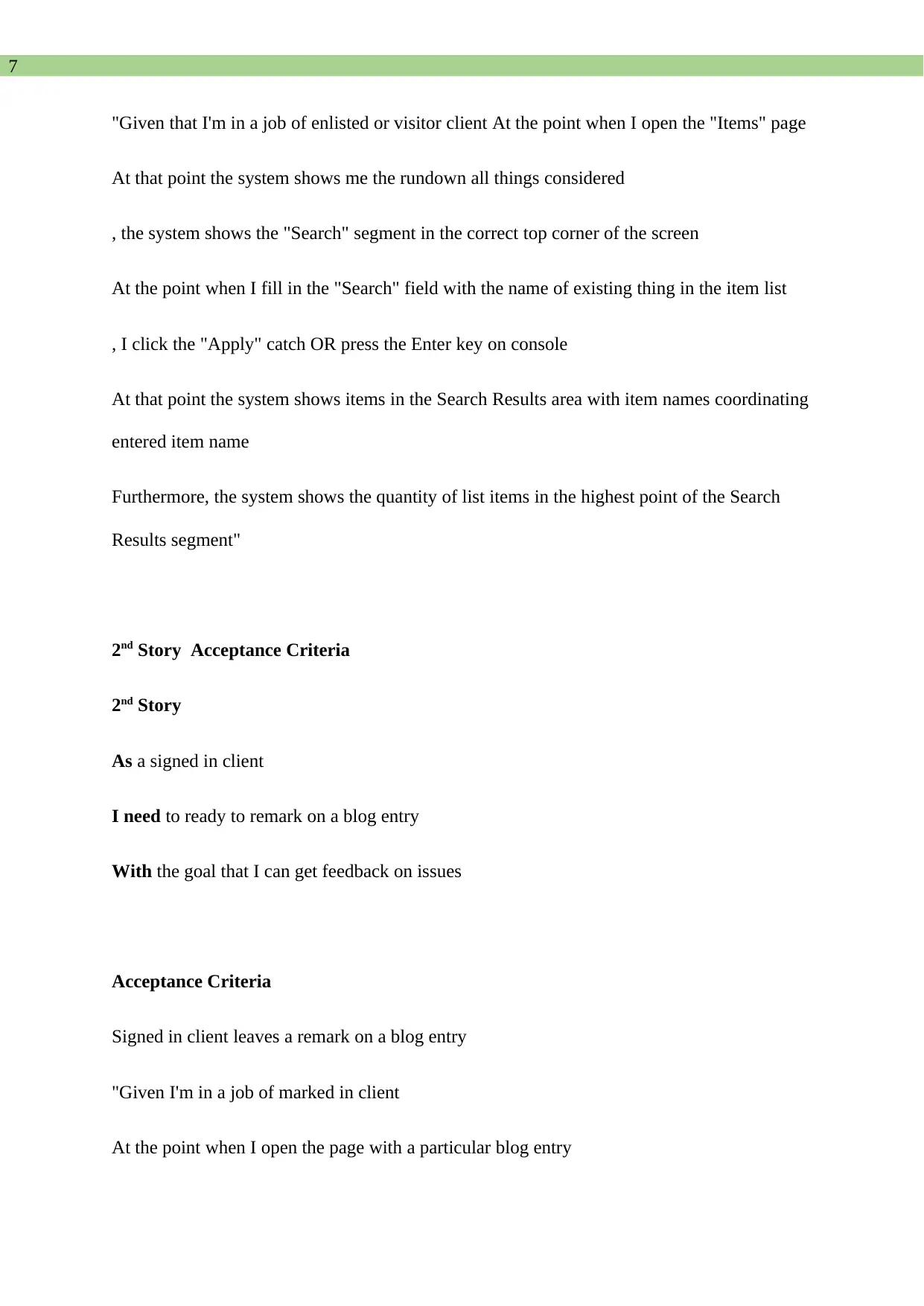
7
"Given that I'm in a job of enlisted or visitor client At the point when I open the "Items" page
At that point the system shows me the rundown all things considered
, the system shows the "Search" segment in the correct top corner of the screen
At the point when I fill in the "Search" field with the name of existing thing in the item list
, I click the "Apply" catch OR press the Enter key on console
At that point the system shows items in the Search Results area with item names coordinating
entered item name
Furthermore, the system shows the quantity of list items in the highest point of the Search
Results segment"
2nd Story Acceptance Criteria
2nd Story
As a signed in client
I need to ready to remark on a blog entry
With the goal that I can get feedback on issues
Acceptance Criteria
Signed in client leaves a remark on a blog entry
"Given I'm in a job of marked in client
At the point when I open the page with a particular blog entry
"Given that I'm in a job of enlisted or visitor client At the point when I open the "Items" page
At that point the system shows me the rundown all things considered
, the system shows the "Search" segment in the correct top corner of the screen
At the point when I fill in the "Search" field with the name of existing thing in the item list
, I click the "Apply" catch OR press the Enter key on console
At that point the system shows items in the Search Results area with item names coordinating
entered item name
Furthermore, the system shows the quantity of list items in the highest point of the Search
Results segment"
2nd Story Acceptance Criteria
2nd Story
As a signed in client
I need to ready to remark on a blog entry
With the goal that I can get feedback on issues
Acceptance Criteria
Signed in client leaves a remark on a blog entry
"Given I'm in a job of marked in client
At the point when I open the page with a particular blog entry
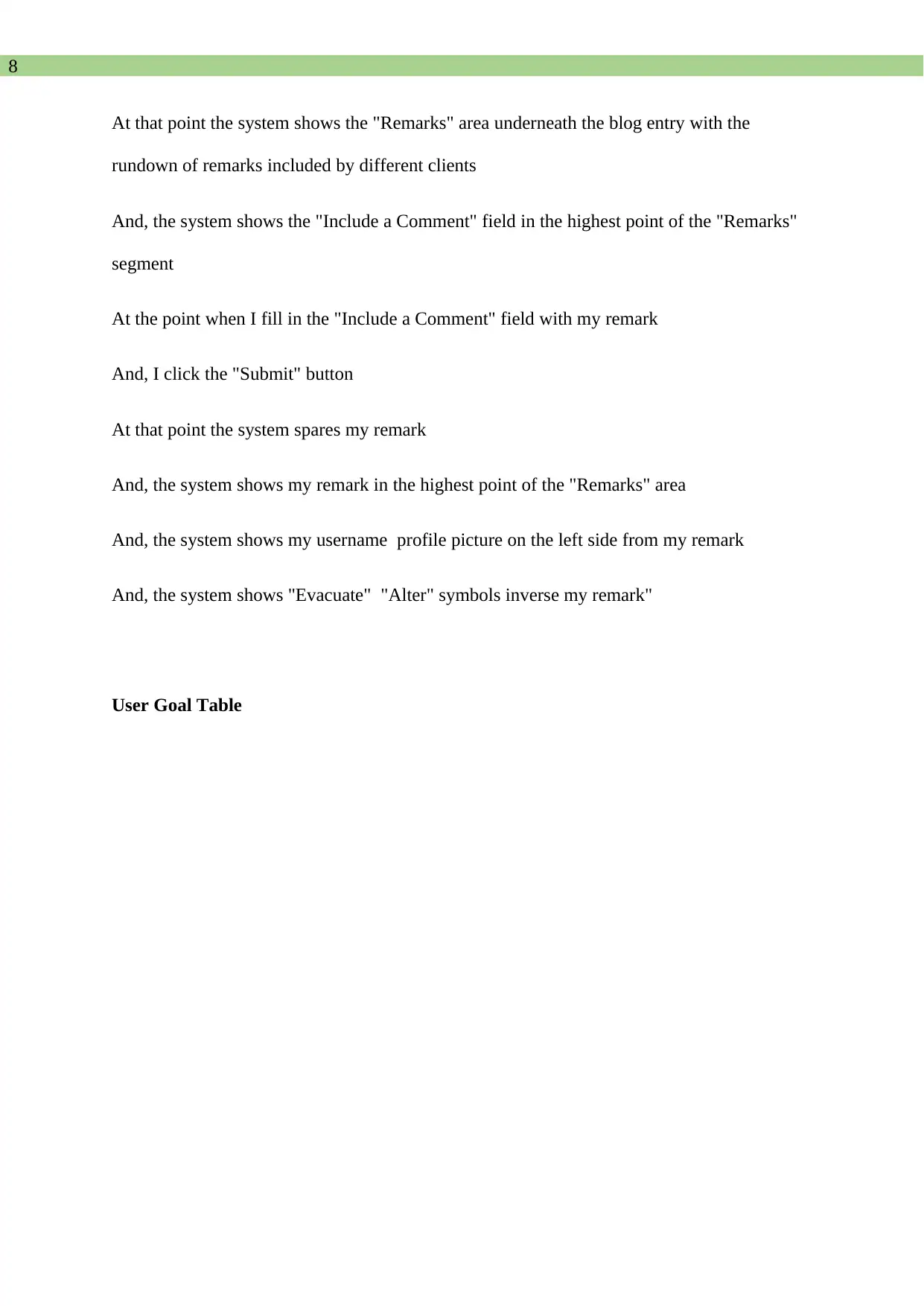
8
At that point the system shows the "Remarks" area underneath the blog entry with the
rundown of remarks included by different clients
And, the system shows the "Include a Comment" field in the highest point of the "Remarks"
segment
At the point when I fill in the "Include a Comment" field with my remark
And, I click the "Submit" button
At that point the system spares my remark
And, the system shows my remark in the highest point of the "Remarks" area
And, the system shows my username profile picture on the left side from my remark
And, the system shows "Evacuate" "Alter" symbols inverse my remark"
User Goal Table
At that point the system shows the "Remarks" area underneath the blog entry with the
rundown of remarks included by different clients
And, the system shows the "Include a Comment" field in the highest point of the "Remarks"
segment
At the point when I fill in the "Include a Comment" field with my remark
And, I click the "Submit" button
At that point the system spares my remark
And, the system shows my remark in the highest point of the "Remarks" area
And, the system shows my username profile picture on the left side from my remark
And, the system shows "Evacuate" "Alter" symbols inverse my remark"
User Goal Table
⊘ This is a preview!⊘
Do you want full access?
Subscribe today to unlock all pages.

Trusted by 1+ million students worldwide

9
Use Case Descriptions
Use Case Name: Place Order
Actors:
Customer
Satisfaction System
Charging System
Use Case Descriptions
Use Case Name: Place Order
Actors:
Customer
Satisfaction System
Charging System
Paraphrase This Document
Need a fresh take? Get an instant paraphrase of this document with our AI Paraphraser
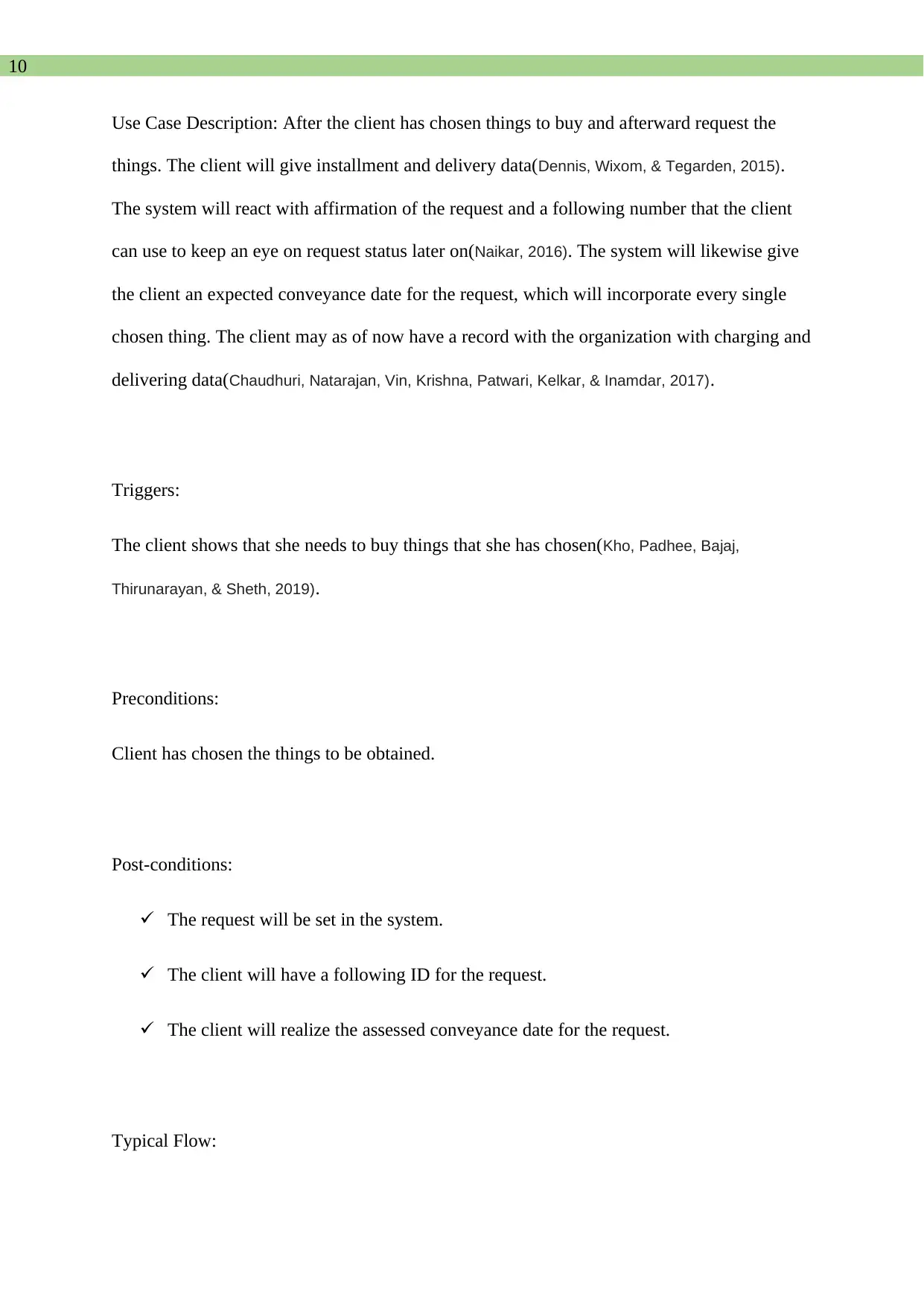
10
Use Case Description: After the client has chosen things to buy and afterward request the
things. The client will give installment and delivery data(Dennis, Wixom, & Tegarden, 2015).
The system will react with affirmation of the request and a following number that the client
can use to keep an eye on request status later on(Naikar, 2016). The system will likewise give
the client an expected conveyance date for the request, which will incorporate every single
chosen thing. The client may as of now have a record with the organization with charging and
delivering data(Chaudhuri, Natarajan, Vin, Krishna, Patwari, Kelkar, & Inamdar, 2017).
Triggers:
The client shows that she needs to buy things that she has chosen(Kho, Padhee, Bajaj,
Thirunarayan, & Sheth, 2019).
Preconditions:
Client has chosen the things to be obtained.
Post-conditions:
The request will be set in the system.
The client will have a following ID for the request.
The client will realize the assessed conveyance date for the request.
Typical Flow:
Use Case Description: After the client has chosen things to buy and afterward request the
things. The client will give installment and delivery data(Dennis, Wixom, & Tegarden, 2015).
The system will react with affirmation of the request and a following number that the client
can use to keep an eye on request status later on(Naikar, 2016). The system will likewise give
the client an expected conveyance date for the request, which will incorporate every single
chosen thing. The client may as of now have a record with the organization with charging and
delivering data(Chaudhuri, Natarajan, Vin, Krishna, Patwari, Kelkar, & Inamdar, 2017).
Triggers:
The client shows that she needs to buy things that she has chosen(Kho, Padhee, Bajaj,
Thirunarayan, & Sheth, 2019).
Preconditions:
Client has chosen the things to be obtained.
Post-conditions:
The request will be set in the system.
The client will have a following ID for the request.
The client will realize the assessed conveyance date for the request.
Typical Flow:

11
The client will demonstrate that she needs to arrange the things that have just been
chosen.
The system will show the charging and transporting data that the client recently put
away.
The client will affirm that the current charging and dispatching data ought to be
utilized for this request.
The system will introduce the sum that the request will cost, including pertinent
assessments and transportation charges.
The client will affirm that the request data is exact.
The system will furnish the client with a following ID for the request.
The system will present the request to the satisfaction system for assessment.
The satisfaction system will furnish the system with an expected conveyance date.
The system will introduce the evaluated conveyance date to the client.
The client will demonstrate that the request ought to be put.
The system will demand that the charging system should charge the client for the
request.
The charging system will affirm that the charge has been put in for the request.
The system will present the request to the satisfaction system for handling.
The satisfaction system will affirm that the request is being handled.
The system will demonstrate to the client that the client has been charged for the
request.
The client will demonstrate that she needs to arrange the things that have just been
chosen.
The system will show the charging and transporting data that the client recently put
away.
The client will affirm that the current charging and dispatching data ought to be
utilized for this request.
The system will introduce the sum that the request will cost, including pertinent
assessments and transportation charges.
The client will affirm that the request data is exact.
The system will furnish the client with a following ID for the request.
The system will present the request to the satisfaction system for assessment.
The satisfaction system will furnish the system with an expected conveyance date.
The system will introduce the evaluated conveyance date to the client.
The client will demonstrate that the request ought to be put.
The system will demand that the charging system should charge the client for the
request.
The charging system will affirm that the charge has been put in for the request.
The system will present the request to the satisfaction system for handling.
The satisfaction system will affirm that the request is being handled.
The system will demonstrate to the client that the client has been charged for the
request.
⊘ This is a preview!⊘
Do you want full access?
Subscribe today to unlock all pages.

Trusted by 1+ million students worldwide
1 out of 18
Your All-in-One AI-Powered Toolkit for Academic Success.
+13062052269
info@desklib.com
Available 24*7 on WhatsApp / Email
![[object Object]](/_next/static/media/star-bottom.7253800d.svg)
Unlock your academic potential
Copyright © 2020–2025 A2Z Services. All Rights Reserved. Developed and managed by ZUCOL.

